30 June 2006
29 June 2006
Yes, Virginia, We Are Devolving

Eric Larsen has a new book out, and has posted an excerpt on his website... and it's an interesting read.
In A Nation Gone Blind: America in an Age of Simplification and Deceit, Larsen asserts that we are fucked. We have substituted abstractions (identity politics) of what the world is and means for actually looking at what is there, have allowed corporate greed to shape us into consumers instead of thinkers, and basically no longer have the cognitive tools to create meaningful political, intellectual, or artistic discourse.
Of course, my kneejerk reaction is, "Yup." But of course this puts me out of a job. So... fuck this guy! Surely we can keep thinking and producing our way out of this mess, right? I'm still thinking... you're still thinking. I'm not ready to cue the fat lady.
And it seems like he has no plan for moving past the flattening effect of identity politics on intellectual discourse, except to reject it. This is ridiculous. Thickening the crust of the local Women's Studies Department by asking harder questions and having more arguments seems like a better strategy (ie, it admits that postmodern theory happened).
But man... I can reject what Larsen is doing with his thoughts, but the thoughts themselves are powerful. Read this excerpt of the excerpt:
"the observable pattern is simply this: Great numbers of people will not talk about great political matters that are unprecedented or of the most towering and important consequence. For example, they won't talk about the possibility of interpreting the Supreme Court's intervention in the 2000 election as the equivalent of a coup or the installation of a junta. And they won't talk about the possibility that the Bush administration knew that 9/11 or something like it was coming but did nothing to prevent it since it would be useful to their own political interests. That is, people will not even entertain the possibility of such ideas.
But why on earth not? I'm not asking for agreement on any such questions, but I am asking—no, I'm imploring—that it be permissible to consider them. To make it something not considerable seems to me the equivalent of willful blindness and very dangerous. I have an acquaintance who is an internationally recognized and highly honored senior professor at a major—no, an illustrious—university. Admittedly, he is conservative politically and considers himself so, but it seems to me that conservatism is one thing and denial another. In an exchange, I asked him whether or not law is built on precedent. Yes, he said, in extremely large part. I asked him if the court's intervention in the 2000 election was a first-time thing and unique or whether it had a precedent. A first-time thing, he said. So I asked: Doesn't the Court's action then stand as a precedent in this area of law, making it more rather than less likely that the Court might again enter into a similar electoral matter and that a parallel or corollary finding might be handed down again? No, he said: It doesn't and it won't.
Even my acquaintance's deep conservatism can't explain this simple stubbornness: after all, he's done something akin to saying "a dog is a cat," or "a dog is not a dog." He would never admit that he'd done so, but hasn't he, in effect, said, "A precedent is not a precedent"?
On the face of it, an absurdity. But I think I understand it, at least to some extent, just as I think I understand the refusal of my colleagues, friends, and other acquaintances even to entertain the notion that the Court's action could conceivably be understandable as a coup. And the reason is that the very thought is unbearable. It is unspeakable. In a word, it's unreal.
Indeed it is. And yet that's the very last reason not to speak of it. "
28 June 2006
Individualism Is Dead!
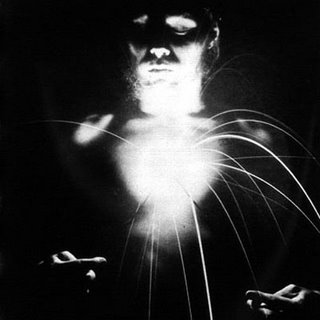
There are grand thoughts out there about craft, the NYC Board of Education and its scattershot approach to teaching art (although from personal experience I know that art should not take this personally... science is equally dismal), and these thoughts are stacking themselves into a great hopeful shape that points upward and asks, "What is my role here as an individual? What can I do? What is this art thing for?" Most recently from Speaking of Ashes:
The writer for the New York Times is unable to process that such sturdy attacks, body blows from both left and right, come about because it's language is based in the same nothing-reality of the adolescent's notebook filled with scrawled AC/DC logos and 4-wheel drive trucks. That is to say, it is a language based on the narrow drive of the individual stringing thoughts together
in succession, unable to allow thoughts to come up, through language, to describe situations WITHOUT moral judgement.
This statement (I think) makes an enormous cognitive leap: it supposes that the individual can choose how to organize her thinking so that her relevance to the larger culture is either maximized or minimized. Holy shit! That's power, unassailable and integral. And it's a great doorway into why contemporary art is so aimless. And it gives some insight into how to reinvest contemporary art with relevance and direction. The AC/DC logos say it all.. well, Ashes could have said pentagrams or unicorns or any other lameass teenage icon that thoroughly infested Chelsea a year or two ago. And while this fad mercifully passed, the fads that replaced it tend to function similarly:
When I go to Chelsea, I see a world full of crap/icons/material that is shuffled around to maximize one artist's individuality at a time. This can take many forms, from the obsessive documentation of some artist's private experience to the showcasing of some artist's "obsessive research interest" (art as term paper), to an artist thinking that they own a way of working or worse, a whole medium.
This obsession with the indivudal is a zero-sum game. It flattens the experience of art into party banter:
Artist: "I am obsessed with coming-of-age films. Aren't you?"
Viewer: "No"
Artist" "Well, then, you won't understand all the layers of meaning in this piece, which culls its iconography from the very important movie, "Poltergeist III"
This impulse to maximize individualism is exactly what I learned in school, too. These artists are following a sincere, necessary impulse in the easiest way. They want to get to the unknown, and in a world where everything is a freaking mouse click away, they are mining what should be forgotten and creating an echo chamber.
Maximizing relevance to the larger culture requires a different approach. It involves sharing oneself with the rest of the world and ceasing to worship oneself as an individual. I think that many artists still think of themselves as uncharted water that is interesting for others to sail. I don't blame them for falling into this "Pollock said it, I believe it, that settles it." trap, but the world has changed. Individualism is turning into its own strange tyrrany. It's being used to convince poor people in red states to vote against their own best interests, keep the kids I taught in Crown Heights last year lusting after bling even though they don't have any money, and keep global warming a political ("personal virtue") issue, and not a scientific fact. Individualism leads to Frank Rich's Truthiness. It is actively being used to turn us into easily mollified sheep who care more about the sense that their Tivo and amazon "knows who they are" than the fact that we are totally fucking up the whole middle east and killing thousands of people doing it.
Individualism is distorting the social and political landscape in absolutely monsterous ways.
Artists who reinforce this obsession with individualism are not just being useless and stupid, not just being behind the curve. They are actively working a culture-machine that they might even mistakenly think has long forgotten them. This is good news because for the first time in years I have convinced myself that art has any power to do anything at all.
26 June 2006
Youth Diatribe Antidote
Courtesy this Sunday's Times Magazine. If misdirected kvetching, open season on kvetching, rekvetching, and lingering over how ignorant it was to kvetch in the first place has left you with a bit of a whining hangover or--worse--despondent because you are not young and hot, take heart. Jeff Garlin has good advice for you.
This man has serious bad health days, keeps getting mistaken for George Wendt, pretty consistently considers himself a second fiddle, and is doing just fine. He is doing show business the hard way, and he is doing it with serious integrity.
Artists, please stop moaning that you need a pretty face or ten years shaved off your resume and cling to the funnyman's truth:
"You get everything you need by being good."
This man has serious bad health days, keeps getting mistaken for George Wendt, pretty consistently considers himself a second fiddle, and is doing just fine. He is doing show business the hard way, and he is doing it with serious integrity.
Artists, please stop moaning that you need a pretty face or ten years shaved off your resume and cling to the funnyman's truth:
"You get everything you need by being good."
23 June 2006
MakerThinker: Power
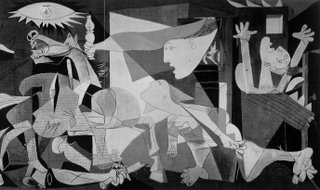
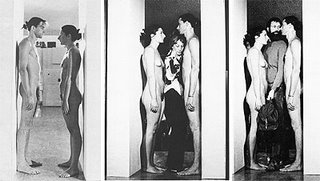
Makerthinking is bottom-up, explores instead of dictates, and is relationship-based. It's not about revolution, it's about evolution, and this relationship to power is important because it is innate, and is therefore harder to undermine or co-opt.
Makerthinking is simply manipulating the world and watching what the effects of that manipulation are. Rather than imagine a utopia or attempt to process or decry the despair of this dystopia, or even have an idea the makerthinker asks the world, "What happens if I do this?"
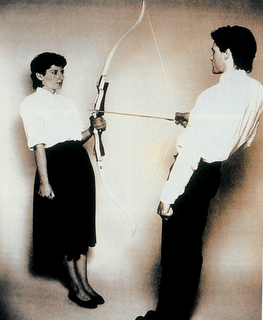
This act is more powerful than one might think, and is powerful in a way that is relevant right now. Marina Abramovic and Ulay harnessed this power more directly, and with higher stakes, than... well, than anyone else needs to, and to powerful effect. Their collaborative work is all about finding and exploiting direct, physical power relationships.

This work can only be read in terms of power, but what kind of power? Ulay and Abramovic are not representing the proletariat like Rivera or Siqueros, and are not assuming responsibility for a grand idea like a war. Rather, they are making actual war with one another, in countless little ways that get across a whole another point. To look at Guernica is to understand a moment in history when one human being was entitled to think of himself as important enough to tell us all about the horrors of war. To look at Abramovic and Ulay's body of collaborative work is to understand that war is made up of acts by individuals, and that we all have a stake in war.
Or to put it another way, Guernica tells us what to think about war. Abramovic and Ulay point out that we are war.
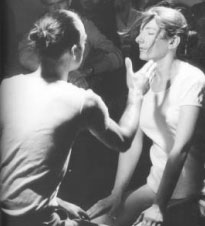
Makerthinkers refuse the distancing action of intellectual thought or art that illustrates ideas by forcing the thinking to happen within the sphere of their own body. Makerthinkers refuse to make magic or fall into grand ideas or make us out to be more than what we actually are. Instead of assigning value to the world from the inside of their minds out, makerthinkers mine what actually happens in search of evidence about our relationships to the world we inhabit. This is a det of small-t truths that anyone can find and own--a bottom-up rearrangement of power that evolves from questioning where you are and what you are doing. This is an actual manifestation of the people's power. It is critical to behaving morally in a democracy. It is the only kind of power that evades king-of-the-hillism (and its corrolary, co-optation).
And at a time when our relationships to the surrounding world are making us lobsters in a pot, when the Rove Engine has made us all complicit in not caring enough about the fact that we, people in a democracy, are Iraq--when we have intellectualized ourselves into a highly attenuated, scary, unsustainable world of global corporate feudalism...when we actually are waging fucking jihad...
...any other kind of power or big-t Truth rings hollow.
20 June 2006
Paradise Not

Reblogging sucks, I know, but I can't help it. Geoff Manaugh, quit blowing my mind! I have nothing to add but dumbstruck awe.
(Image courtesy CLUI)
New Orleans Elegy--Now In Bronze

Thanks again to the Venerable Puffin Foundation for enabling the huge outflow of cash! I posted pictures of the wax awhile back, and here it is in all its so fucking heavy I can't lift it off the table glory!
It's based on a flooding map of New Orleans that was published in the New York Times last September after Katrina.

Thanks also to Jeffrey Spring at Modern Art Foundry, for not chasing away all these cool bits of flashing. I like the way they mimic the streets. How could you plan this stuff?

The steel streets remain embedded in the bronze, and will react with one another forever, causing corrosion. All bronze patinas are kinds of corrosion, so this means that the patina is activated--it will change over time. The patina is also integrated. I didn't add the colors later, they are the result of how the thing is made.
16 June 2006
Luis Jimenez Taught Me Stuff

Luis Jimenez died installing a sculpture June 13, 2006. He was sometime faculty at my undergrad alma mater, and I looked at this sculpture, Man On Fire, just about every damn day of my twentieth decade. I had a job working with his lithographs...he was important to me when I was in Tucson. He was the first person who ever made the relationship between sculpture and power explicit for me.
Lifting anything heavy is so dangerous. He shouldn't have been standing anywhere near the load. What a terrible, avoidable way to die. What terrible news. His work was important to the region and to the whole world. He empowered the latino community big time and was a huge thinker of even huger thoughts. What a fucking loss.
13 June 2006
Hope Springs Eternal

Jerry Saltz is doing that cute little hopeful dance he does sometimes... you know, when he sees something he wants to say in something that isn't very good. The larger point he is making with Ted Riederer's review is totally worthwhile. And watching Saltz bend over backwards and put one leg inside his ear and stand on one testicle in order to do it is fun.
And he should be doing this dance. Criticism that is effective is constructive--it helps to point us where we want to go. And yes, it's completely worth it to ferret out the "aesthetic of reconstruction" and essential hopefulness that Riederer is bashing into the ground with a presentation that manages to be didactic and obtuse. Crushing. And since Saltz is being the good cop, I feel liberated.
Art's stuck in the cul-de-sac of the individual artist's experience, and the bottom line is that it is existentially impossible to share your experience with someone else...directly. Empathy is limited. All this art like Riederer's that originates from The Private Artist's Gesture is doomed to lameness, no matter how delightfully hopeful or reconstructive that gesture is, because it does not acknowledge this fact:
My job as the viewer is not to wish I was you and fling myself into you. So I am going to look at your documentation and see it as the dry, mysterious bullshit that it is.
You know how sometimes the best way to get across how something felt is to lie and embellish? Maybe one way to get to an "aesthetic of reconstruction" is to stop clinging to the veracity of our own mastubatory experiences and go dream up some shit that considers how the audience feels. Honestly, I don't need this Humpty-Dumpty tedium. Saltz's point is gorgeous and deeply true. But art isn't broken--it just needs to get out more.
EDITED TO ADD: I have been thinking about this today, and want to firmly position myself within this problem. I would not feel comfortable dealing with Riederer's work in this way if I did not have so many of my own irrelevant private experiences so thoroughly documented. Just ask any grad school colleague of mine... the hours I have spent staring at my own boring video footage of myself doing something that was great for me, not quite realizing over and over again that I have an inside and an outside... it is truly astounding.
11 June 2006
Studio Shots

I'm working on a couple of new things that are made out of latex paint. They're pretty funny. In this shot, they are both suspended upside-down. I gloop huge quantities of paint all over their bottoms. When they are upside-down like this, they're not much to look at yet.

But this is what the foreground one looks like when it gets flipped over. Eventually it will get snipped off the stretcher bars and stand on its own. I like that it's getting structure as if by magic. I started by crocheting this topographic shape out of twine, and of course it had no structural integrity of its own. Then I started adding paint, and the weight of the paint pushed it into three dimensions. The paint is also providing the only structural integrity. Structure within structurelessness...Cool, no?


The background rust is someone else's rad piece. Cal Lane will be in this summer's EAF06 show at the park. She's doing really cool things to that dumpster, you should come by and check it out.

This one's harder to see, I couldn't flip it over. It might never work. It's a map of San Diego, and is made using the same technique as New Orleans Elegy, except that it's paint instead of wax. The paint makes it really heavy. It broke its stretcher bars, and so it's skewered on this patched-together thing for the time being. Right now the paint and the armature are just fighting. But it might get so heavy that the paint starts to assert itself as a structural force of its own... Maybe.
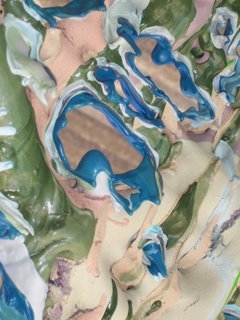
Anyway, it's doing a cool layering thing, and working with color scares the crap out of me, so that's good.
10 June 2006
Fucking Truth
In today's NY Times Magazine, George Soros says "People don't care about the truth." Yesterday, ArtSoldier asked if art has the capacity to be dangerous.
These are connected. If there is no truth, then nothing can be dangerous.
These are connected. If there is no truth, then nothing can be dangerous.
08 June 2006
MakerThinker: To Joel... It's Still Not Craft, My Dear!

First of all, I am in the market for a new title. MakerThinker sounds like software. Ideas?
Joel Murphy, you vote that craft is makerthinking most of the time, and Leisurearts also veers in that direction in their thoughtful analysis of cooking v. cheffing. And I want to make an argument that is, I think, mostly semantic. This whole problem of doing the work and learning from the work itself is so fucking political, so wrapped up in power. There is no power in overusing the word craft, in making the word craft encompass too much. And for me, this is about reclaiming intellectual power.
You argue that there is good craft and bad craft. Good craft is care, experimentation and basically figuring out how to pay attention and retain those little bits of knowledge that come your way when you do stuff. Bad craft is about right and wrong. I see where you are going with this, and have similar sentiments. But I need to throw in different words because this is confusing and collapses an idea that could sit up straight and tall.
I would like to make a working definition of craft that separates it from MakerThinking. The purpose of this is not to denigrate craft. Rather, my goal is to find and expose those smart relationships to craft. I want to examine ways to plug into craft from an intellectually powerful place, and thereby maximize its value.
Right now, its value is not being maximized because the only real discussions going on in the art world about how things are done are marred by this stupid class war. Dragging out the word craft in this context is a tactical error, because it sits too tidily inside the existing paradigm. To be above craft is to have money and succeed in the art market. To gnash and sweat over craft is to show off your provincial state school education and guarantee that you will never get a chance to make your own work if you were silly enough to move to New York City, which might as well be Babylon or Gomorrah right now if you happen to be walking around Chelsea. This is a losing proposition for the MakerThinker. It promotes division. Thinkers assume that they know what craft means and assume that it's a commodity. Makers use craft to judge and build walls between themselves and the art that is being made right now.
To do that is to ignore a whole big useful body of work that depends on thinking as a maker thinks. Dennis Oppenheim, Dan Graham, Barry La Va, Bruce Nauman, William Wegman, Eleanor Antin, Marina Abramovic and Ulay, Yoko Ono, Chris Burden, Vito Acconci... all those crazy endurance freaks and all that betacam video footage of people doing ordinary things... the seventies is very relevant to this discussion, and could blow a big hole in all that mealy research-based neoconceptualism that reigns today. All that performance art was interesting precisely because it explored a set of kinetic thinking strategies that stand outside craft.
But that performance art tradition wears the word craft poorly, which is good, because we need a new word or two, and some definitions.
Craft: the study and application of any building or making tradition. Craft connotes history. It is passed from one person to another directly through apprenticeships and teacher/student relationships, and indirectly through books and videos and remembering every time you do a dumb thing. It is a way of working that acknowledges right and wrong ways to do it. Craft-based thinking has its foundation in the fact that people have been making stuff for millenia. It smartly uses this collective body of information gleaned from daily interactions with materials to describe and codify best practices.
Craft is concerned with maximizing human output, both in terms of quality and quantity. Craft says: Don't re-invent the wheel. Learn from my mistakes. That way will scar the wood, do it like this. Flour that cake pan. Good craftspeople are a dream to watch in a shop. They minimize effort all day long. They do only what they have to do. Craftspeople don't flail for a reason. They stand atop and move from the craft, the history, of what they are doing.
Craft is extremely powerful. Learning a craft is a great way to practice larger MakerThinker concepts, like how to pay attention to what you are doing. But it is crucial to keep in mind that craft is powerful because it is telling you what to do. It is telling you that for hundreds of years people have faced very similar sets of problems when working, and it offers solutions that are valuable because they have been tested by millions of others.

Doorway to Heaven was not good craft! Any good craftsperson will tell you to minimize your body's toil, your body's wear and tear! Doorway to Heaven was a different thought process entirely. Doorway to Heaven tested Burden's existing knowledge about electricity with Burden's body. The high stakes of the gesture combine with the title to create a beautiful little poem that transcends what we know about electricity and evokes fear of mortality and individualism and ego.
Craft is not absent. Without craft, or the bodies of physical knowledge that have been collected over millenia, Burden could have killed himself, or knocked down a museum wall, or just made a lame gesture. But Burden is not a craftsperson. Burden is a makerthinker. He uses craft as a knowledge base, a reference.
Joel, you are right. Craft is always there. It must be, because it is the body of existing knowledge, and it would be retarded to stop recording what you learn so that you don't have to relearn it every day. It is the kinetic thinker's library. But there is a serious pitfall to talking about craft that needs to be made explicit. Craft does exist so that you don't have to think so much. And even as Dale Chihuly and Jeffrey Deitch are smoking cigars in some richly appointed backroom, lounging in their faith that they understand this and are therefore on top of the maker/thinker divide, there is still intellectual heavy lifting to be done. There are people using craft as a lever and not a crutch (Burden, SRL, YOU!). There are people who use craft as a springboard or as resistance (Dan Graham, Barry La Va, The Great Negator Alan Kaprow). There are people doing jujitsu with craft (Streb), and there are people who are actively makerthinking without dealing in craft at all (Nauman, Sophie Calle).
These specific relationships between kinetic thinking and craft are worth teasing out, and can only be thoroughly examined when the word craft is not asked to take on both the body of knowledge itself and the act of using the knowledge. That would be like calling writing "books".
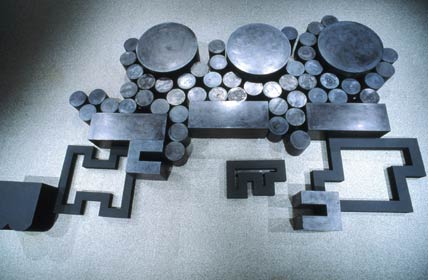
04 June 2006
Sculptural Thoughts

Courtesy Geoff Manaugh. Turns out we make all our things out of the earth. It's all gotta come from somewhere, I guess...
Image: New Cornelia Tailings mine, near Ajo AZ (close to where I grew up), image courtesy CLUI
03 June 2006
MakerThinker: Don't Trust Craft

Dan Graham, Body Press (1970-1972)
I haven't been very clear about this MakerThinker thing. I see from Serena's comment that this could be misconstrued as an argument for craft.
Craft is about right and wrong, preserving tradition, not reinventing the wheel. The teaching of craft in art school tends to create artist-technicians who so clearly know what is right and what is wrong that they will never do it the really fucked up/interesting/revolutionary way. Craft dulls the potential MakerThinker. It creates false security and throws up barriers to understanding. Craft is conservative.
I TAed a sculpture class for Jennifer Pastor once. And my most important job was to hang out by the sculpture tech and make sure he didn't convince any of the students do it "the right way" or "the easy way". Technicians are expedient, and sculpture is rarely interesting when it is done expediently. The right way is often irrelevant. What Jennifer wanted was to get the students to find the way it needed to be done. This is MakerThinking, and it has nothing to do with learning how to weld, although it can involve welding.
The most expressive or smartest way to tackle a problem can really rankle what the craftsperson inside knows to be true. I fight all the craft I learned at my crappy provincial state school education as much as I use it.
02 June 2006
01 June 2006
MakerThinker: Definition
Makerthinkers are opening new doors by asking nonverbal questions during the making process. Their thinking is physical and relationship-based, and that physical thought process is evident in their work. Makerthinkers are bottom-up. Rather than prove a concept (Serra, Ray), they investigate a set of problems (Streb, Nauman) by setting up if-then propositions. This fiddling, questioning, and active negotiation informs aesthetic choices, and becomes the meaning of the work. Makerthinkers engage in active conversation with process/physics/materials, and are not attempting to prove as much as uncover or discover.

Bruce Nauman, Finger Touch With Mirrors and Finger Touch #1

Bruce Nauman, Finger Touch With Mirrors and Finger Touch #1




